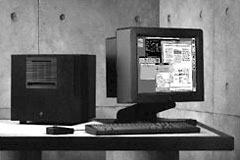Anyone with an interest in computing – especially in Unix-based OSes – cannot have failed to notice the hype surrounding the release of Mac OS X. OS X is a whole new ball game in Macintosh computing. For many years Apple have been trying to find a suitable replacement for their sophisticated (but rapidly dated) Mac OS.

After a flirtation with Jean Louis Gassé’s BeOS, the return of Apple cofounder Steve Jobs precipitated a focus shift to NeXT technologies. NeXT was the company formed by Jobs after being unceremoniously booted out of Apple by then-CEO and former PepsiCo man, John Sculley. NeXT manufactured the famous 680×0-based black hardware that offered performance beyond anything available on the Macs and PCs of the time, but NeXT never really found a commercial base for the machines and instead opened up their famous NeXTstep OS. It is this OS that is the basis of Mac OS X.
Reworked and ported to the PowerPC platform, NeXTstep has become Darwin, the open source kernel of Mac OS X. Including key Unix technologies such as Mach and having full POSIX compatibility, Darwin/OS X does for Unix what NeXT tried to do in the early 1990s. It combines extreme power with ease of use.
There is a problem, however. The entry price is steep. You must have at least a G3 processor, and 128 MB of RAM is required to do any serious work. If your Mac is pre-G3, your options for using Mac OS X are limited to expensive processor upgrade cards, and even then Apple will not guarantee support (see XPostFacto for info on installing OS X on unsupported hardware).
This is where Linux comes in.
There are versions of Linux for nearly every Mac made in the last ten years, even 680×0 based machines. Over the next few years, software for the classic Mac OS will dry up as users – even in the publishing industry famed for its inertia – switch to OS X.
Where does that leave your once prized Mac?
Many people are now booting up Linux as a second system on their Macs. Old Power Macs such as the 7200 make fine firewalls and small office servers, and if configured properly they can make great desktop machines. iMacs make great small and inexpensive Linux desktops, and if aesthetics are not a concern, you can add a second IDE hard drive quite easily, though it will hang out of the back of the machine. The G4 PowerBook is probably the best Linux capable laptop on the market.
The problem, as always, is user level software. Despite the fact that the Mac absolutely dominates the creative industries and some areas of science computing, it is a minority platform. Linux on the Mac (or any PPC system) is a minority within a minority. However, things may change very soon.
Let’s look at why.
First off, OS X has an open source core in the form of Darwin. Darwin has even been ported to x86 systems. This has allowed a lot of standard Unix applications to make their way to OS X and then PPC/Linux, and vice versa. GUI applications may take a little longer, but work is already underway. There are several X Window servers for OS X, including open source projects and Tenon Intersystems commercial (and excellent) effort.
Free
Linux is free, as in “free beer.”
Yes, despite the hoo-hah about free meaning open, the fact remains that Linux has many more no-cost useable small application programs, such as MP3 players, calendars, PIMs, and so on, than any other OS. This may seem relatively unimportant, but if money is a concern for you or your organisation – and let’s face it, if you’re using a Power Macintosh 7200 rather than a G4 it probably is – then a highly configurable OS that you can alter to suit your machines with a large selection of simple productivity applications is likely to be of interest.
Linux is ugly compared to the Mac OS. Many Linux users disavow this and can come up with a hundred and one reasons to say otherwise, but from the perspective of user interface, Apple consistently got it right, while others, notably Microsoft, haven’t.
That said, KDE and GNOME have come on in leaps and bounds, and though I still prefer other GUIs (such as those of the Mac OS, BeOS, and, of course, OS X), these are a pleasure to use compared to their predecessors.
Add to this the fact that with the great Mac-On-Linux application the Mac OS can actually be run in an X Window, and it’s dream come true time. If you think that this sounds awkward, remember that BeOS users have been doing it for years with SheepShaver and that Mac OS X itself uses similar technologies for running classic Mac applications.
If you’re interested in running Linux or BSD on PowerPC Macs, consider joining our Linux on PowerPC Macs group on Facebook.
This article was originally published in Linux Magazine (UK).
Keywords: #ppclinux #maclinux
Short link: http://goo.gl/ChrSl8
searchword: linuxorosx

